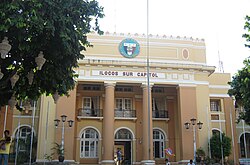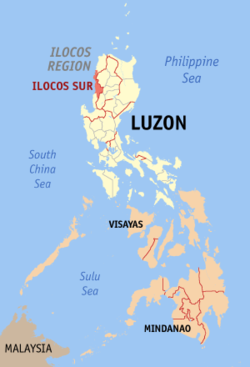Ilocos Sur
Ilocos Sur (Ilocano: Abagatan nga Ilocos; Tagalog: Timog Ilocos) is a province in the Philippines located in the Ilocos Region in Luzon. Vigan City, located on the mouth of the Mestizo River is the provincial capital. Ilocos Sur is bordered by Ilocos Norte and Abra to the north, Mountain Province to the east, La Union and Benguet to the south and the South China Sea to the west.
Ilocos Sur was founded by the Spanish conquistador, Juan de Salcedo in 1572. It was formed when the north (now Ilocos Norte) split from the south (Ilocos Sur). At that time it included parts of Abra and the upper half of present-day La Unión. The current boundary of the province was permanently defined through Act 2683, which was signed in March 1917.
Before the arrival of the Spaniards, the coastal plains in northwestern Luzón, stretching from Bangui (Ilocos Norte) in the north to Namacpacan (Luna, La Union) in the south, were a region called the Ylokos. This region lies in between the China Sea in the west and Northern Cordilleras on the east. The inhabitants built their villages near the small bays on coves called looc in the dialect. These coastal inhabitants were referred to as Ylocos which literally meant from the lowlands. The entire region was then called by the ancient name Samtoy from sao mi ditoy which in Ilocano mean our dialect. The region was later called by the Spaniards as Ylocos or Ilocos and its people Ilocanos.
...
Wikipedia




